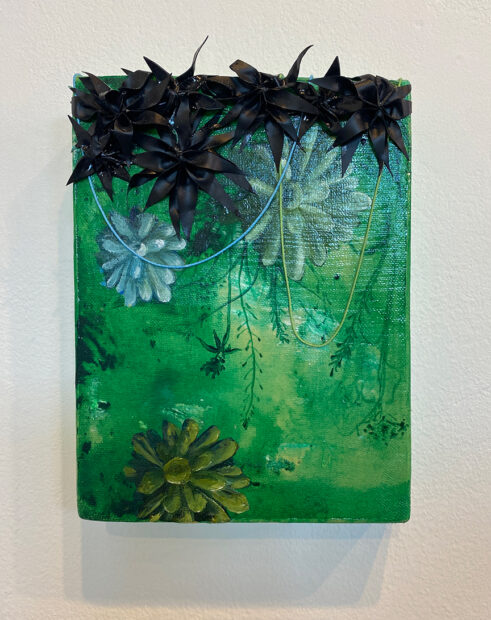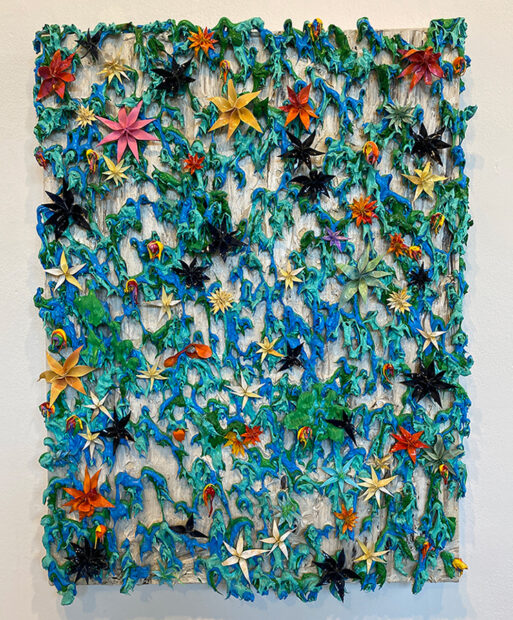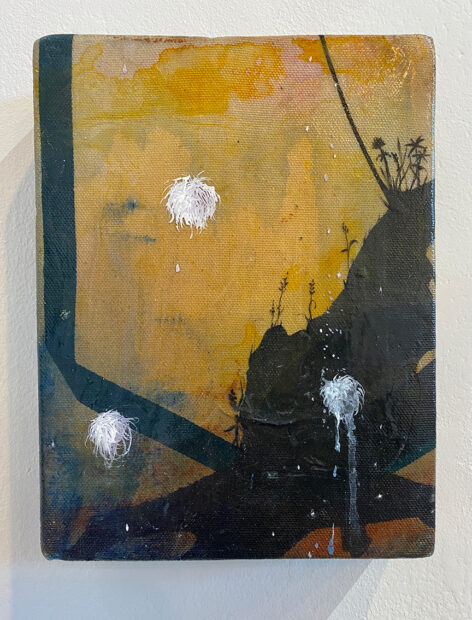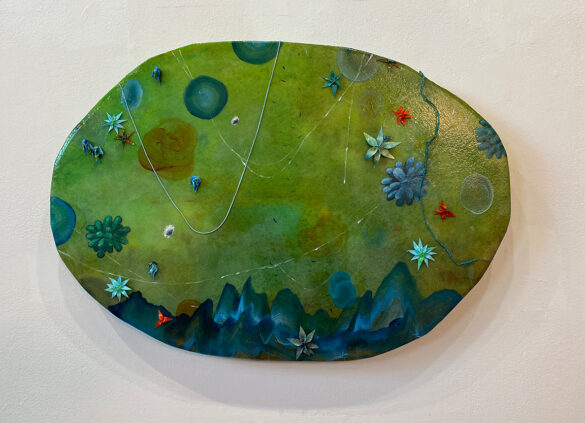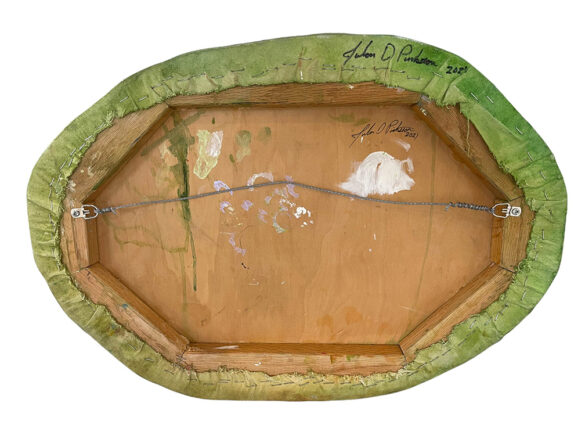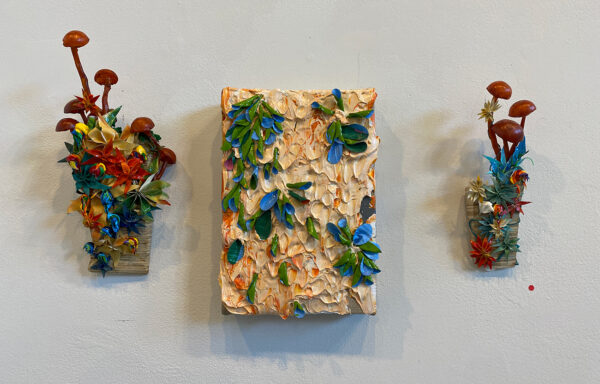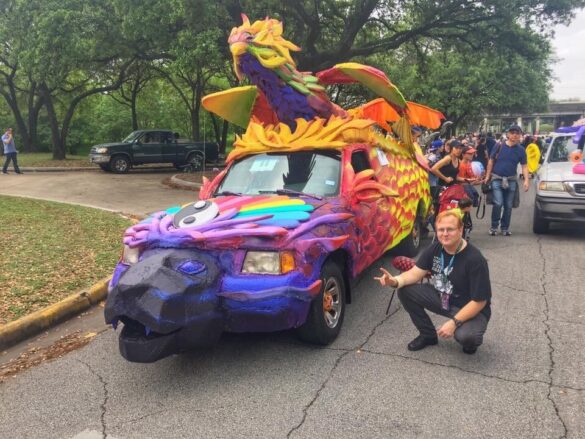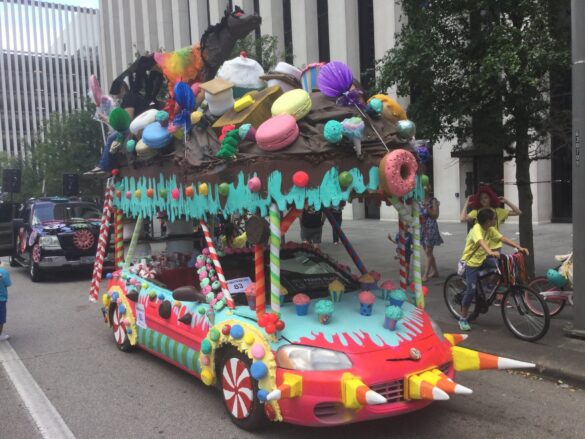Last week, I stopped in at Ro2 Art in Dallas to see Julon Pinkston’s current exhibition, Marshwiggle Apparitions. Having seen Pinkston’s work in 2014 as part of a two-person show also at Ro2, Luscious: Erica Stephens & Julon Pinkston, I remembered his thick applications of paint and was surprised (and pleased) to see the ways his practice has evolved in the years since. Still deeply intrigued by the physicality of his medium, Pinkston’s current solo show takes familiar methods to unexpected places.
His canvases are created using a variety of paint applications, ranging from thin layers reminiscent of photograms to thicker elements, some of which look like they’ve come straight from the paint tube, while others have been applied and blended in a manner resembling cake frosting. In this show, Pinkston also expands on the technique of sculpting three-dimensional elements from dried paint. In the past, the product of this process often looked more like duct tape, but in this new series, these pieces have been shaped to resemble flower petals and leaves.
To learn more about Pinkston’s current show, I chatted with him via email. Below are lightly edited excerpts from our conversation.
Jessica Fuentes: You’ve been showing with Ro2 since 2014. How has your work evolved over the past eight years?
Julon Pinkston: Since the pandemic started, I started to add some flat, illusionistic aspects to my paintings. Before 2014, my paintings were very thick colorful impasto, almost an ongoing series of work, each painting informing the next. These last two years, I started making the flower-esque shapes as a response to an author friend of mine wanting me to make a cover design for him. His book involved a botanist and hidden fairy people, hence the flower shapes. From there, it fed into my larger body of work, which is why there seems to be a hidden narrative in the paintings.
JF: Are you open to sharing more about the narrative?
JP: This is hard…not to give away too many details because my friend has not published yet, it is a work in progress. The narrative, which the series started from, is about a group of four people living in an isolated house and expansive garden — and a hidden realm, hidden fairy people which slowly become more and more revealed over the course of the story. I loved the fantasy aspect of this story, and the idea kept me entertained for a long time. The garden, the mushrooms, the stains which become atmospheric and hinting of a landscape, all of that came from that book.
JF: The title of the show references a species from C. S. Lewis’ The Chronicles of Narnia. First introduced in The Silver Chair, the reader only really meets one Marshwiggle, named Puddleglum. It’s clear through both Lewis’ description of the character and Puddleglum’s mannerisms and quips that he and his species are pessimistic and quite serious by nature. What was the significance of referencing these characters in your work?
JP: I could say the pandemic [inspired this], and I have little kids. Gloomy and pessimistic with a spark of adventure, maybe that’s me sometimes too — certainly these last two years. The character Puddleglum was such an interesting character, almost poetic. I have been reading a lot of children’s books and youth fiction these last two years. To me, they are very comforting. Also again, there is this hidden narrative I have been playing with over the last couple years. The titles of the individual works refer to poems, stories, and even an anime film I used to watch repeatedly in the 80s. I guess at the end of the day, I wanted the title of the show to reflect all of those personal things that have helped me get through all this.
JF: Your works are created using acrylic paint that is applied and manipulated in different ways. Can you share a little about how you work? How did you come to explore these various application processes? Is there a reason why you stick with acrylic rather than use other materials?
JP: I probably got into using acrylic paint because of the viability and versatility of the medium. First and foremost, it is very easy to take care of, very difficult to damage, and very archival. Acrylic paint is elastic, so you can stretch and pull it, but it goes back to its original form. I like how acrylic paint can act as a glue — the quick drying time, or slow drying if you want it slow. It can be thick or thin, like oil paint or like watercolor. I love that I can make acrylic skins or molded forms. The flower shapes in the works are paint that has been dried on glass or silicone, peeled, cut, shaped, clamped, and glued, all using acrylic paint. For the longest time I have enjoyed saying [that the medium of my pieces is] “acrylic paint on canvas,” and having a lot of elements that don’t look like what many people would think of as acrylic paint. I have added string, wire, and sawdust into the mix over the last couple years for some aspects of these paintings, but it is still mostly acrylic paint.
JF: I was really struck by some of your round and oval canvases that are slightly misshapen. Jordan Roth, Ro2’s Director, showed me the back of one of these to reveal how you constructed it. When did you start making canvases like this? What interests you in these imperfect forms?
JP: I have been making oddly shaped objects to paint on forever. I have been making my own canvases and panels since 1999, and everything in this exhibition was made from recycled lumber. I love the idea of breaking from the traditional shapes from time to time; it keeps things interesting, and it is challenging to pull off an oddly shaped painting.
JF: Similarly, I was taken with your two small works Sticky Wicker and In hiding that feel like small wall vases. The structures reference the trompe l’oeil edges of some of the other canvases. How do these pieces relate to the other works in this exhibition?
JP: Those two are unique, more sculpture than painting. I have several chunks of plywood in my studio I glued and shaped, so I wanted to see if I could make them into art. Although they are made from the exact same material as the other paintings, they certainly seem to be going their own direction.
JF: Looking ahead, what upcoming projects do you have in the works?
JP: Right now, I am helping Frank Black Middle School students make an art car, which I hope to make our fifth award-winning art car. Other than that, I will continue to listen and see where the work takes me.
Want to learn more about Pinkston’s work? He will present a virtual Art Talk on Saturday, February 12 at 2 pm. Find the link on Ro2’s instagram account. Julon Pinkston: Marshwiggle Apparitions is on view through February 12.


